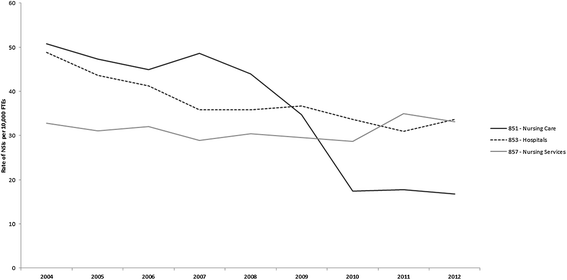Trends in needlestick injury incidence following regulatory change in Ontario, Canada (2004-2012): an observational study
- PMID: 25880621
- PMCID: PMC4393628
- DOI: 10.1186/s12913-015-0798-z
Trends in needlestick injury incidence following regulatory change in Ontario, Canada (2004-2012): an observational study
Abstract
Background: A number of jurisdictions have used regulation to promote the adoption of safety-engineered needles as a primary solution to reduce the risk of needlestick injuries among healthcare workers. Regulatory change has not been complemented by ongoing efforts to monitor needlestick injury trends which limits opportunities to evaluate the need for additional investment in this area. The objective of this study was to describe trends in the incidence of needlestick injuries in Ontario prior to and following the establishment of regulation to promote the adoption of safety-engineered needles.
Methods: An observational study of needlestick injuries obtained from two independent administrative data sources (emergency department records for the treatment of work-related disorders and workers' compensation claims) for a population of occupationally-active adults over the period 2004-2012.
Results: Comparing the year prior to the regulation being established (2006) to three years after the regulation came into effect (2011), needlestick injury rates in the health and social services sector that were captured by workers' compensation claims declined by 31% and by 43% in the work-related emergency department records. Rates of workers' compensation claims associated with needlestick injuries declined by 31% in the hospital sector, by 67% in the long-term care sector and have increased by approximately 1% in nursing services over the period 2004-2012.
Conclusions: Two independent administrative data sources documented an overall reduction in needlestick injuries in the province of Ontario following a regulatory requirement to adopt safety-engineered needles; however, a substantial burden of occupational needlestick injuries persists in this setting.
Figures
References
-
- Shields M, Wilkins K. Findings from the 2005 National Survey of the Work and Health of Nurses. Ottawa: Statistics Canada; 2006.
-
- Lee JM, Boteman MF, Zanthakos N, Nicklasson L. Needlestick injuries in the United States: epidemiologic, economic and quality of life issues. AAOHN J. 2005;53:117–34. - PubMed
-
- Ontario Regulation 474/07 Needle Safety. 2007. [http://www.e-laws.gov.on.ca/html/regs/english/elaws_regs_070474_e.htm]
-
- Second Reading, Bill 1279, Safe Needles Save Lives Act. 2005. [http://www.ontla.on.ca/house-proceedings/transcripts/files_html/2005-03-...]
Publication types
MeSH terms
Grants and funding
LinkOut - more resources
Full Text Sources
Other Literature Sources


